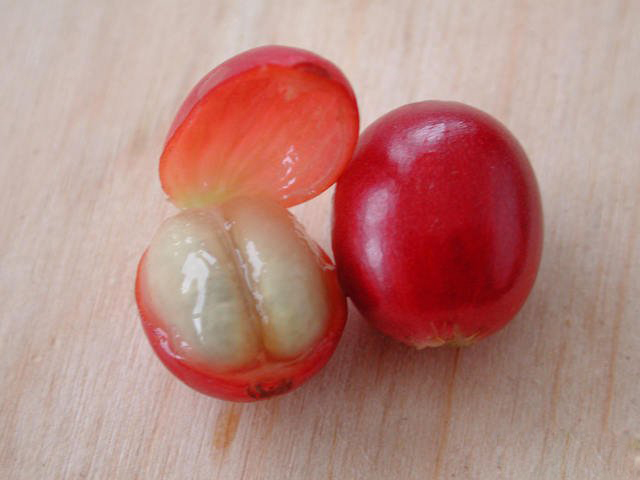Introduction to the knowledge of roasting coffee beans join the roaster
Note the sound changes-coffee beans make two popping sounds during roasting. The first popping sound is low, indicating that starch is beginning to convert to caramel and water is evaporating with carbon dioxide. The second burst sound is more intense and sharp, which is the sound of coffee bean cell fiber breakage, at this time should immediately stop heating, and as soon as possible with cold air to reduce the temperature of the beans. The timing of the first explosion and the second explosion can vary greatly, so find the best roasting conditions for different beans, pay attention to the color and taste changes-coffee beans will continue to warm, from green to light brown, then a small amount of oil auburn, then a large amount of oil is shiny dark brown. At this point, you can no longer bake, otherwise the coffee oil on the surface of the beans will dry, and will emit a lot of smoke and burnt coffee roasting is a knowledge, the age, density, hardness and moisture content of raw beans will affect the quality of roasted coffee; Even the relative humidity and temperature on the day of roasting cannot be ignored. It is best to put the coffee beans on 2-5 days, so that the carbon dioxide in the coffee beans can be discharged in large quantities before drinking. The aluminum foil bag of the one-way ventilation valve selected by Hong Kong Coffee Association can preserve the coffee beans, which can prevent the air from entering and cause oxidation. It can also allow carbon dioxide to be discharged to ensure that the coffee beans are kept in the best condition of freshness. Since green beans absorb a lot of heat during roasting, the first cracking occurs at this time, when sugar begins to convert into carbon dioxide, water continues to evaporate, and the aroma of coffee gradually radiates and forms coffee fat. This pyrolysis reaction can last until the second explosion (2nd cracking), but at the completion of the second explosion, should immediately, and as soon as possible with cold air to reduce the temperature of the beans, so that you can obtain the highest caramelization Another phenomenon is the roasting process, coffee beans will release carbon dioxide, after roasting ripe beans will continue to exhaust within 30 days, this helps to keep the coffee beans fresh, this is because in the exhaust of carbon dioxide, oxygen molecules are not easy to invade and destroy the flavor of coffee, coffee beans will not be oxidized. If coffee beans are oxidized, the flavor will quickly deteriorate, so the coffee brewed with fresh coffee beans has a particularly good flavor. Coffee beans have an earthy smell before roasting, and after roasting, they will emit a strong aroma. The roasting degree of coffee beans also affects coffee flavor and caffeine content. The lighter the roast, the stronger the acidity and the higher the caffeine content. The deeper the roast, the lighter the sourness, the more bitter the sweetness, and the lower the caffeine content

Important Notice :
前街咖啡 FrontStreet Coffee has moved to new addredd:
FrontStreet Coffee Address: 315,Donghua East Road,GuangZhou
Tel:020 38364473
- Prev

The planting environment of coffee trees introduces which countries are the most suitable for growing coffee
The first flowering period of the coffee tree is about three years old. the white five-petal tube-shaped flowers are filled with a faint scent of jasmine and the inflorescences are arranged in dense clusters. Flowers wither after two or three days of blooming and begin to bear fruit after a few months. The fruit is a drupe with a diameter of about 1.5 cm, which is green at first, then turns yellow gradually, and turns red after ripening, which is very similar to cherries.
- Next

Fresh Coffee Beans Coffee Roasting Curves with Coffee Flavors Boutique Coffee Beans
1. The air inside this crack has a different thermal conductivity than the beans outside. If it causes the two temperatures to be different. Most likely the problem lies in the fact that the air is much warmer than the beans. For example, it's too hot to get out of the oven, or the beans aren't dry enough. You'll see that the middle is more burnt than the sides. Generally, after burning, the explosion will be a little faster, perhaps not dense. At this point, it's possible that some of the beans
Related
- Beginners will see the "Coffee pull flower" guide!
- What is the difference between ice blog purified milk and ordinary milk coffee?
- Why is the Philippines the largest producer of crops in Liberia?
- For coffee extraction, should the fine powder be retained?
- How does extracted espresso fill pressed powder? How much strength does it take to press the powder?
- How to make jasmine cold extract coffee? Is the jasmine + latte good?
- Will this little toy really make the coffee taste better? How does Lily Drip affect coffee extraction?
- Will the action of slapping the filter cup also affect coffee extraction?
- What's the difference between powder-to-water ratio and powder-to-liquid ratio?
- What is the Ethiopian local species? What does it have to do with Heirloom native species?

